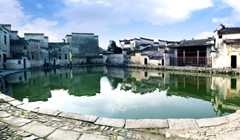Line Five: Fantasy happy world tour
 Introduction to the spots
Introduction to the spots
|
Wuhu city rests in a beautiful place with many trees and flowers. Fantawild, an adventure theme park, is located in the city. Fantawild is the biggest fourth generation theme park in Asia and is nicknamed “the technological miracle in Asia". New rides add to the thrill. It’s the place where the past meets the future, reality dances with imagination and dream and magic go hand in hand. |
★ Langya Mountain ★
Langya Mountain, three km southwest of Chuzhou City, has rolling peaks, gurgling springs and luxuriant vegetation. It is a national key scenic and historic interest zone and a national forest park.
It is abundant in animal and plant resources. For instance, it is home to 54 species of birds currently under the protection of the Sino-Japanese Agreement of Protecting Migratory Birds. The Langya elm and Zuiweng elm peculiar to Langya Mountain are two of rare tree species in the country; and China's most completely preserved natural secondary forests in a limestone area, a transitional zone from sub-tropical to warm-temperate climate, add to the area's uniqueness.
Apart from these natural resources, the mountain also gathers numerous historical sites, such as the ancient Qingliu Pass, Langya Temple, Pavilion of the Old Drunkard, Fengle Pavilion, Portrait of Goddess of Mercy by Wu Daozi (680-759), a great painter of the Tang Dynasty (618-907), and the stele with the inscriptions of Record on the Pavilion of the Old Drunkard, which was written by Su Shi (1037-1101), a writer and calligrapher in the Song Dynasty (960-1279). The beautiful mountain is not only an ideal place for people to conduct scientific research, revisit their country's history or simply seek a return to nature, but a fine destination for tourists to relax in a beautiful natural and cultural setting.
★ Wuhu Fantawild Adventure Theme Park ★
Situated in the Wuhu Yangtze River Bridge Development Area, Wuhu Fantawild Adventure Theme Park is the largest fourth-generation theme park in China, featuring high-level technologies. It covers an area of 1,250 square km, including 530 square km of land and 720 square km of water.
As an amusement park with many themed attractions, it offers various entertainments to visitors, including the Sky Sailor—a world top-ranking entertainment item which simulates flying in the sky, the Space Scheduled Flight—a large-scale space flight simulation program, and the Solomon's Seal—the first large-scale multi-water-curtain adventure item in Asia.
All in all it is a feast for the imagination, a magic dreamland, and a kingdom full of adventures! No visitor has ever felt disappointed to be there!
★ Maren Mountain ★
Maren Mountain Scenic Area is located on the southern bank of the Yangtze River, where Fanchang, Tongling and Nanling counties of Anhui province meet. A wonderful combination of famous mountain peaks and rivers and the simplicity of the surrounding countryside, it enjoys a reputation as "Zhangjiajie in South Anhui and Lesser Huangshan Mountain by the Yangtze River." It covers a total area of 3.3 square km.
As the only provincial-level forest park in Wuhu, the scenic zone is richly endowed with animal and plant resources. It is home to some rare animals, such as vultures, ring-necked pheasants, roes, deer, giant salamanders, white-breasted foxes and pangolins; and to over 600 plant species representing 68 families, of which merely the natural woody plants constitute dozens of distinct varieties. It is covered with flourishing evergreen woods, with a forest coverage as high as 95 percent.
The scenic area has unique landforms, and features the steep and lofty peaks and oddly shaped outcrops, the flourishing trees and green bamboos, the rare birds and animals and the gurgling springs running through the old temples. In addition, the Blessing Cauldron, known as the "No. 1 Incense Burner in China" is a must-see. It is 9.9 meters high and weighs 88 tons. On its surface the Chinese character (meaning blessing in English) is repeated 999 times, and inside there is an exhibition hall with an area of 48 square meters, where some precious cultural relics unearthed in the inverted-Y-shaped cave and the valuable data with regard to those on-the-spot pictures taken when Chinese and foreign specialists were exploring and excavating the cave are on display. The Blessing Cauldron leads the world in terms of its originality, molding technology, volume and weight.
★ Caishiji ★
Known as Niuzhuji in ancient times, Caishiji lies at the western foot of Cuiluoshan Mountain, about five km southwest of Ma'anshan City. Caishiji, together with Chenglingji in Yueyang and Yanziji in Nanjing, are known as the "Three Famous Rocks along the Yangtze River", of which Caishiji is acclaimed as the finest due to its unique natural scenery and strong cultural background.
One of the key national scenic and historical interest zones, Caishiji boasts the largest Memorial Hall of Li Bai (701-762), a famous poet of the Tang Dynasty, the well- known Sanyuan Cave, the imposing Santai Pavilion, the Art Hall ofLin Sanzhi (1898-1989), a sage of cursive script, Yuanmengyuan Garden with its Huizhou architectural style, the riverside ancient plank road, and Cuiluo Cove. Moreover, Caishiji serves as an ideal place for tourists to enjoy a combination of beautiful poetry and the wonderful natural scenery.
Caishiji is one of the oldest Buddhist sacred lands. The Guangji Temple on the hill has enjoyed a high reputation in the areas south of the Yangtze River ever since it was first built in the Chiwu reign period of the state of Wu (238-250) during the Three Kingdoms period (220-280). Down through the ages, bells in the morning and drums in the evening have been heard; the fragrant smoke of the joss sticks has been released; and religious activities have been held. These combine to draw a sort of mysterious veil over Caishiji.
★ Ma’anshan Water Cultural Relaxation ★
Bath is an important part in Chinese traditional culture. The rules of fasting for 3 days and then taking a bath before formal events can be found in royal code dating back as early as Shang and Zhou Dynasty. From Han to Tang Dynasty, the bath culture has matured and the upper classes have gotten used to different ways of baths like vapor bathing, spring bathing and medical bathing. The methods and ideas of Chinese traditional medication and health-keeping are introduced in the baths, thus making bath culture all the more attractive in China. Ma’anshan Water Cultural Relaxation integrates bathing, medication, health-keeping and surfing. You’re guaranteed to have a healthy and relaxing time here after a long day’s work.
Editor: Li Jing

 What's so special about the line
What's so special about the line

